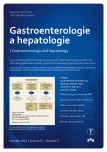Development of procedures for the treatment of acute liver failure
Authors:
E. Kieslichová 1
; M. Ročeň 1; S. Fraňková 2
Authors‘ workplace:
Klinika anesteziologie, resuscitace a intenzivní péče, IKEM, Praha
1; Klinika hepatogastroenterologie, IKEM, Praha
2
Published in:
Gastroent Hepatol 2013; 67(5): 426-430
Category:
Hepatology: Review article
Overview
During the last decade there have been many changes in how we care for patients with acute liver failure which provides them with a better chance of survival. With improved diagnostic capacities the cause of disease can be diagnosed more frequently than previously. It is important to determine the prognosis and to implement a specific therapy. Improvement in the overall management of patients in intensive care (intracranial pressure monitoring, prevention and treatment of early signs of intracranial hypertension, therapeutic hypothermia, microbiological monitoring and prophylaxis, modalities of renal replacement therapy), development of surgical techniques and perioperative care are the factors that have led to improved survival after an urgent liver transplantation for acute liver failure. Despite many improvements in the care of the patients with acute liver failure, mortality without liver transplantation is still high. Therefore, better understanding of the pathogenesis of acute liver failure and providing effective supportive therapy remains a core issue.
Key words:
acute liver failure – liver transplantation – intensive care
The authors declare they have no potential conflicts of interest concerning drugs, products, or services used in the study.
The Editorial Board declares that the manuscript met the ICMJE „uniform requirements“ for biomedical papers.
Submitted:
4. 9. 2013
Accepted:
2. 10. 2013
Sources
1. Lee WM, Stravitz RT, Larson AM. Introduction to the revised American Association for the Study of Liver Diseases Position Paper on acute liver failure 2011. Hepatology 2012; 55(3): 965–967.
2. Bernal W, Auzinger G, Dhawan A et al. Acute liver failure. Lancet 2010; 376(9736): 190–201.
3. Bernal W, Auzinger G, Sizer E et al. Intensive care management of acute liver failure. Semin Liver Dis 2008; 28(2): 188–200.
4. Bernal W, Hyyrylainen A, Gera A et al. Lessons from look-back in acute liver failure? A single centre experience of 3300 patients. J Hepatol 2013; 59(1): 74–80.
5. Lee WM, Hynan LS, Rossaro L el al. Intravenous N-acetylcysteine improves transplant-free survival in early stage non-acetaminophen acute liver failure. Gastroenterology 2009; 137(3): 856–864.
6. Shawcross DL, Davies NA, Mookerjee RP et al. Worsening of cerebral hyperemia by the administration of terlipressin in acute liver failure with severe encephalopathy. Hepatology 2004; 39(2): 471–475.
7. KDIGO Clinical Practice Guideline for Acute Kidney Injury. Kidney International Supplements 2012; 2(1): 124–138.
8. Bernal W, Hall C, Karvellas CJ et al. Arterial ammonia and clinical risk factors for encephalopathy and intracranial hypertension in acute liver failure. Hepatology 2007; 46(6): 1844–1852.
9. Faybik P, Hetz H, Mitterer G et al. Regional citrate anticoagulation in patients with liver failure supported by a molecular adsorbent recirculating system. Crit Care Med 2011; 39(2): 273–279.
10. Patel S, Wendon J. Regional citrate anticoagulation in patients with liver failure – time for a rethink? Crit Care 2012; 16(5): 153.
11. Plauth M, Cabré E, Campillo B et al. ESPEN Guidelines on Parenteral Nutrition: hepatology. Clin Nutr 2009; 28(4): 436–444.
12. Germani G, Theocharidou E, Adam R et al. Liver transplantation for acute liver failure in Europe: outcomes over 20 years from the ELTR database. J Hepatol 2012; 57(2): 288–296.
13. McPhail MJ, Wendon JA, Bernal W. Meta-analysis of performance of Kings's College Hospital Criteria in prediction of outcome in non-paracetamol-induced acute liver failure. J Hepatol 2010; 53(3): 492–499.
14. Faybik P, Krenn CG. Extracorporeal liver support. Curr Opin Crit Care 2013; 19(2): 149–153.
15. Rocen M, Kieslichova E, Merta D et al. The effect of Prometheus device on laboratory markers of inflammation and tissue regeneration in acute liver failure management. Transplant Proc 2010; 42(9): 3606–3611.
16. Ročeň M, Kieslichová E, Merta D et al. Terapie přístrojem Prometheus u pacientů s akutním jaterním selháním – vliv terapie na markery zánětu a regenerace. Anest Intenziv Med 2010; 21(4): 199–205.
Labels
Paediatric gastroenterology Gastroenterology and hepatology SurgeryArticle was published in
Gastroenterology and Hepatology

2013 Issue 5
- Metamizole vs. Tramadol in Postoperative Analgesia
- Metamizole at a Glance and in Practice – Effective Non-Opioid Analgesic for All Ages
- Possibilities of Using Metamizole in the Treatment of Acute Primary Headaches
- Current Insights into the Antispasmodic and Analgesic Effects of Metamizole on the Gastrointestinal Tract
- Spasmolytic Effect of Metamizole
Most read in this issue
- Picoprep – a cleansing agent with dual effect
- Small intestine lymphomas
- Hereditary diffuse gastric cancer
- Liver transplantation for primary sclerosing cholangitis
